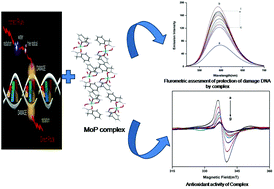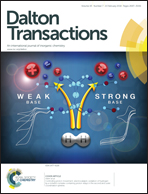Synthesis and structural characterization of dioxomolybdenum and dioxotungsten hydroxamato complexes and their function in the protection of radiation induced DNA damage†
Abstract
The synthesis and structural characterization of two novel dioxomolybdenum(VI) (1) and dioxotungsten(VI) (2) complexes with 2-phenylacetylhydroxamic acid (PAHH) [M(O)2(PAH)2] [M = Mo, W] have been accomplished. The dioxomolybdenum(VI) and dioxotungsten(VI) moiety is coordinated by the hydroxamate group (–CONHO−) of the 2-phenylacetylhydroxamate (PAH) ligand in a bi-dentate fashion. In both the complexes the PAHH ligand is coordinated through oxygen atoms forming a five membered chelate. The hydrogen atom of N–H of the hydroxamate group is engaged in intermolecular H-bonding with the carbonyl oxygen of another coordinated hydroxamate ligand, thereby forming an extended 1D chain. The ligand as well as both the complexes exhibit the ability to protect from radiation induced damage both in CTDNA as well as in pUC19 plasmid DNA. As the damage to DNA is caused by the radicals generated during radiolysis, its scavenging imparts protection from the damage to DNA. To understand the mechanism of protection, binding affinities of the ligand and the complex with DNA were determined using absorption and emission spectral studies and viscosity measurements, whereby the results indicate that both the complexes and the hydroxamate ligand interact with calf thymus DNA in the minor groove. The intrinsic binding constants, obtained from UV–vis studies, are 7.2 × 103 M−1, 5.2 × 104 M−1 and 1.2 × 104 M−1 for the ligand and complexes 1 and 2 respectively. The Stern–Volmer quenching constants obtained from a luminescence study for both the complexes are 5.6 × 104 M−1 and 1.6 × 104 M−1 respectively. The dioxomolybdenum(VI) complex is found to be a more potent radioprotector compared to the dioxotungsten(VI) complex and the ligand. Radical scavenging chemical studies suggest that the complexes have a greater ability to scavenge both the hydroxyl as well as the superoxide radicals compared to the ligand. The free radical scavenging ability of the ligand and the complexes was further established by EPR spectroscopy using a stable free radical, the DPPH, as a probe. The experimental results of DNA binding are further supported by molecular docking studies.


 Please wait while we load your content...
Please wait while we load your content...